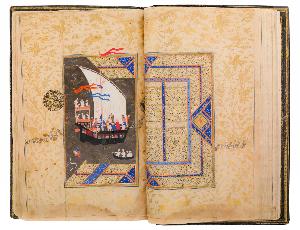Shah Muhammad Al-Katib Al-Shirazi
Shah Muhammad Al-Katib Al-Shirazi
Place: Shiraz
Born: 1546
Death: 1615
Biography:
Shah Muhammad al-Katib al-Shirazi was a Persian calligrapher and painter, born in Shiraz, Iran in 1546 and died in 1615. He was a prominent figure in the Safavid court and is known for his work in the nasta'liq script. Al-Shirazi was also a master of the 'Adili style of calligraphy.
Artistic Career
Al-Shirazi's artistic career flourished during the Safavid period, which lasted from 1501 to 1736. This era was marked by significant contributions to Persian art, including painting, calligraphy, architecture, textiles, ceramics, and metalwork. The Safavid Period Art Movement was characterized by a fusion of traditional Persian styles with new influences from the Ottoman, Mughal, and European cultures. Al-Shirazi's work includes the authorship of the Diwan of Jami, a collection of poetry by the Persian poet Jami, which he illustrated with watercolor paintings. He is considered one of the greatest calligraphers and painters of the Safavid era.
Notable Works and Styles
Some notable aspects of Al-Shirazi's work include his mastery of the nasta'liq script and the 'Adili style of calligraphy. His watercolor paintings, as seen in the Diwan of Jami, showcase his exceptional talent in capturing the essence of Persian poetry. The Safavid Period Art Movement is also notable for its use of vibrant colors and intricate patterns, which can be seen in the works of other artists from this era. For example, the Sheikh Lotfollah Mosque in Isfahan, features intricate tilework and stunning dome, showcasing the artistic skills of the Safavid architects. Key aspects of Al-Shirazi's work include:
- Mastery of nasta'liq script and 'Adili style of calligraphy
- Exceptional watercolor paintings, as seen in the Diwan of Jami
- Contribution to the Safavid Period Art Movement
For more information on Shah Muhammad Al-Katib Al-Shirazi and his work, visit Shah Muhammad Al-Katib Al-Shirazi page on Wikioo.org. You can also explore the Safavid Period Art Movement and other notable artists from this era, such as Johannes Hannot, on Wikioo.org.

